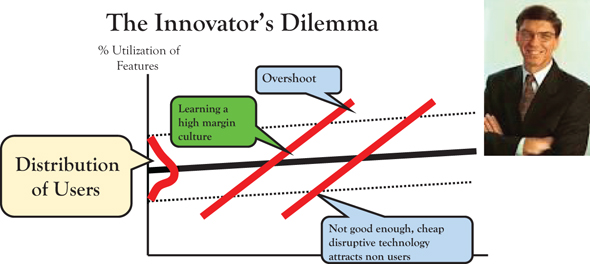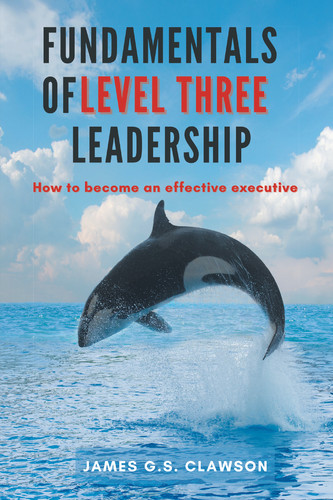Concept
Clayton Christensen at the Harvard Business School (a former colleague and basketball junkie friend) identified a new idea, something every academic hopes to do. Clayton in his book, The Innovator’s Dilemma: When New Technologies Cause Great Firms to Fail, focused on the percent utilization of product features.21 Clayton’s idea in sum was this: In order to add revenues, firms will naturally add features to their products and therefore gradually raise the prices of their products. Ultimately, they are vulnerable to attack by cheaper, less sophisticated new entrants. Thus, the percent utilization of this annual wave of new features defines opportunities for competitors—where there are lower percent utilizations. They can offer fewer features for lower prices, and gain a segment foothold, but then to gain revenues, they, too, begin to add features. So, the dilemma is that established firms who add features may find them unused and hence make themselves more vulnerable to attack.
Example
Honda begins to sell cheap, tiny, 50 cc motorbikes in California. Mercedes Benz and Harley Davidson hardly notice; they metaphorically spit on the cheap, tiny, unsophisticated Honda two wheelers. Honda gains a foothold. Then, to increase revenues, Honda begins to add features and even to create cheap four wheeled automobiles. Again, no threat to the established blue-chip owners of higher priced segments.
Honda adds features: bigger sizes, better engines, heated seats, and revenues grow. Before long, Mercedes Benz begins to notice the growing opportunity costs of sales going to Honda. Likewise at Harley Davidson. Daimler then decides to follow the classic GM strategy of filling out models for various socio-economic strata. They add an E class, a C class, and eventually a Smart car. The tiny Smart car however was built with Daimler culture in a highly automated, very expensive $2 billion dollar plant.
Meanwhile, Honda adds more features and even a new luxury line of cars, Acura, into which they can insert even more features and charge higher margins. In Scandinavia, Volvo begins to work back down the price points with V80, V70, V50, V40, and so on.
Then Hyundai, an unknown Korean company introduces a cheaper, unsophisticated car with a 10 year, 100,000 mile warranty. MB and Acura metaphorically spit on their cheap construction, tiny wheels, thin metal doors, lack of features. And Hyundai gains a foothold. And begins to add features. Eventually, they introduce the Genesis, a luxury brand to compete with Benz and Acura (and now Infiniti and Cadillac).
Meanwhile, Kia, an unknown Korean automobile manufacturer, introduces a cheaper, unsophisticated car … and gains a foothold. And begins to add features.
Concurrently, in the personal computer industry, Steve Jobs is re-hired to try to save the declining fortunes of Apple. He finds a bewildering array of models with myriad features. He simplifies the business by declaring they will focus on four products, retail and commercial and desktop and laptop in each. The company regains control of costs, recovers, … and begins to add features.
Diagram

I find an interesting connection in Clayton’s insights to energy in the workplace. What if we looked at “percent utilization of employees’ energy pools?” Every person has an imaginary pool of energy that they can apply to an activity. How do companies seek to gain access to higher percentages of that pool of employee energy? They add features like bonuses, gold stars, promotions, and so on to incentivize employees to give more to the company. This becomes more and more expensive.
Then, along comes a non-profit with no wages to promise gets people give up evenings and weekends and with full energy. Habitat for Humanity, Red Cross, Salvation Army, Rescue Squads, and so on, get people to dedicate large amounts of personal time with full energy to achieve the organization’s goals.
Challenge
1. Try to identify the marginal value added by each of your company’s products features.
2. How does your company protect itself against cheaper, unsophisticated, substitutes?
3. What features is your company planning on adding to its products?
4. What features are you adding to your personal skill set and how does this affect your expected salary/wage?
5. What cheaper threats do you see to your salary/wage job security?
21 Christensen, C. 2013. The Innovator’s Dilemma: When New Technologies Cause Great Firms to Fail. Cambridge, MA: Harvard Business Review Press.
